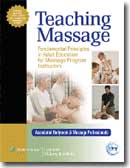Teaching Massage equips you with the knowledge and skills needed to give each individual student every opportunity to
excel in your massage therapy course. You'll learn the gamut of techniques and practices that have proven successful in
enabling adult learners to master massage therapy. All aspects of teaching a massage therapy course are thoroughly
covered, from motivating and inspiring students to designing and implementing lesson plans to working with special
needs students.
Features to Help You Teach a Great Massage Therapy Course?
Learning Objectives beginning each chapter guide your reading by defining your learning goals.
Note Card boxes distill complex concepts down to their essentials for easy review.
Instruction in Action sections recommend activities that enhance and enliven your students' classroom experience.
Ask Yourself boxes at the end of key sections enable you to assess your grasp of important concepts and their
applications.
Teacher Features highlight real stories of inspirational instructors and the impact they have had on the careers of
professional massage therapists and teachers.
Cross-References throughout the text direct you to related content in other chapters.
Online Training Program offers continuing education credits and a framework for developing your teaching skills. The
online course is composed of lectures with audio, activities, and quizzes delivered in short, easy-to-complete segments.
Each chapter has been written by one or more leading massage therapy educators. By sharing their own hands-on classroom
experience, these educators enable you to develop and deliver the best massage therapy course possible.
Chapter 1: You the Instructor
Chapter 2: Massage Students and Body Centered Education (Rick Rosen)
Chapter 3: How People Learn - Theories and Approaches
Chapter 4: Instructional Methods (Suzanne Carroll)
Chapter 5: Motivation and Inspiration (Carey Elizabeth Smith)
Chapter 6: Classroom Management
Chapter 7: Teaching Students with Special Needs
Chapter 8: Designing and Presenting a Lesson
Chapter 9: Tips for Teaching Selected Classes


